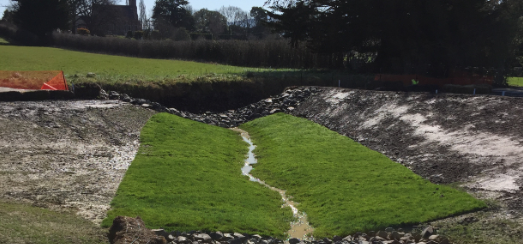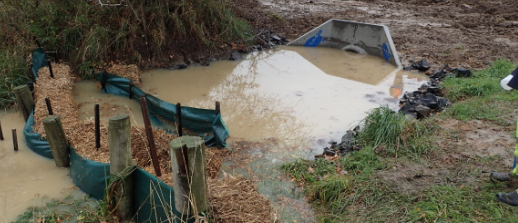PC8 to the Regional Plan comprised eight parts, each targeting a specific topic, covering both urban and rural practices, the latter announced in June covering rural discharges, and farming practices including effluent storage and discharges.
ORC’s General Manager Policy and Science Anita Dawe says for developers the latest urban provisions are aimed at reducing any adverse effects on water quality.
The provisions will enable ORC to have better oversight on the management of earthworks from residential development, to manage sediment from earthworks and ensure there is a robust process to ensure it doesn’t enter water.
“While there were comprehensive rules in place in some District Plans, it is important that ORC was able to achieve our water quality role and the rules provide an important opportunity to more actively manage any sediment discharges which could go to water,” she says.

She described the policy change as “putting a fence at the top of a cliff, instead of an ambulance at the bottom”.
The PC8 “urban topics” changes will also affect operators of reticulated storm and wastewater systems, Ms Dawe notes.
Main changes for property developers
The main changes for property developers are in Part G; sediment from earthworks for residential development, which are permitted activities with no resource consent required, Ms Dawe says.
For residential earthworks to be a permitted activity, developers must not expose more than 2500 square meters of earthworks in any consecutive 12-month period per landholding and the earthworks must not be within 10 metres of a water body, drain, water race or the coastal marine area.
The exposed earth must be stabilised on completion of the earthworks, to minimise erosion and to avoid slope failure.
Soil or debris from earthworks must not be placed where it can enter a water body, drain, race or the coastal marine area.
The earthworks must not result in flooding, erosion, land instability, subsidence or property damage at or beyond the property’s boundary where the earthwork.
Earthworks should not occur on contaminated or potentially contaminated land.
Ms Dawe says if developers cannot meet these requirements, they will need to get a resource consent.

Mediated agreement on urban discharge policies
Also of note for developers is Part A urban discharges policies, where agreement via mediation was reached by all parties; as opposed to going through the Environment Court.
Ms Dawe says Part A of PC8 amended two existing policies and added two new policies to the Regional Water Plan, to provide stronger and clearer policy direction for decision-makers on resource consent applications for discharges from reticulated stormwater and wastewater systems.
She says this is the first step towards a policy framework which gives effect to the National Policy Statement on Freshwater Management 2020.
It indicates the direction which the management of discharges of stormwater and wastewater will take in the new Land and Water Regional Plan, Ms Dawe says.
PC8 is part of a transition toward a new freshwater management framework, being set into the ORC’s new Land and Water Regional Plan, the latter intended to be operative by December 2025, Ms Dawe says.
“PC8 was proposed in order to make a range of amendments to the current water plan provisions to better manage specific urban and rural activities, known to be contributing to water quality issues in parts of Otago,” Ms Dawe says.
Background to Environment Court hearing
PC8 is part of a larger proposed Plan Change, called the Omnibus Plan Change, which was “called in’’ for fast-tracking by Minister for the Environment David Parker in April 2020; and referred to the Environment Court.
In order to manage matters efficiently, the Environment Court separated PC8 into two parts – the primary sector provisions and the urban provisions, to better enable mediation and expert conferencing.
However, pre-hearing mediation between the parties over sediment from earthworks for residential development was unsuccessful, and that was the issue which went before the Environment Court.
At least two Queenstown developers continued to “actively oppose” the application of the PC8 rules within the district, where an earthworks consent had been granted under the Queenstown Lakes District Council plan, the court said in its decision.
The hearing focused on the submitters’ concerns around duplication of the rules with those in the QLDC’s proposed district plan, the court said.
In March this year a ‘memorandum of understanding’ was struck between QLDC and ORC which “supports streamlining the processing and monitoring of resource consents for earthworks for residential development”, the court noted.
The court’s decision on PC8 (Urban topics) was released on 14 June. The appeal period to the High Court has since expired, with no appeals lodged.
Environment Court decision on PC8 (urban topics)
Earlier primary sector provisions
In early-June ORC ratified changes to the operative Regional Plan: Water for Otago, which allowed key parts of the then proposed PC8; related to rural discharges, to become operative.
The PC8’s primary sector provisions - to counter adverse water quality effects of rural land uses– includes new provisions which set minimum standards for animal effluent storage and application to land, for intensive winter grazing, and for the establishment of small sediment traps in intermittently flowing streams.
Further information on earthworks
If people have questions about the rules and resource consents they should email public.enquiries@orc.govt.nz for more information.
